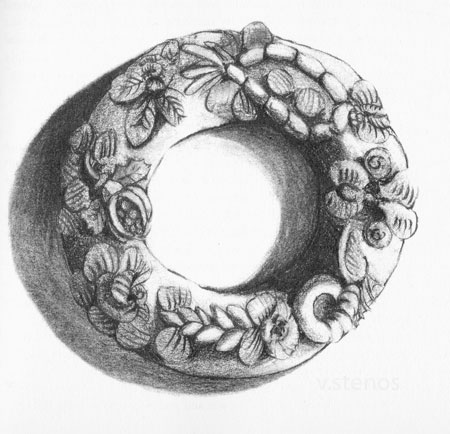Greece, a country of bread eaters, has a rich tradition in decorative, symbolic loaves and this time of year the table is filled with them. One such bread is Christopsomo, Christmas bread, a living tradition in the villages of the Peloponnese and elsewhere.
Long before croissants and prefabricated loaves arrived here, bread was more than just, well, bread. It was a canvas of sorts, upon which all of life’s milestones were expressed. Many of the bread customs of Greece predate Christianity and are rooted in the harvest rituals and the worship of Demeter, goddess of agriculture.
Wheat has always been the staple grain in the Mediterranean. Its harvest cycle symbolizes birth, death and rebirth. In the myths, this cycle is manifested in the story of Persephone, Demeter’s daughter, who was stolen away to Hades but released only for half the year because her mother was unable to keep from turning around to look at her as she made her way out of the Underworld, where she had descended to rescue her. Bread is life in Greece. Christ is referred to as the Bread of Life in the Orthodox tradition; blessed bread is served every Sunday after the Divine Liturgy.
Decorative breads are made for every occasion, including death and mourning, but the loaves that come to table around the holidays are all meant to symbolize good wishes, hope for the future, prosperity, and fertility. They are decorated with ornate sculpted dough figures representing animals, crops, and the family. They are almost universally round, the circle a symbol of eternity, or, alternatively, cross-shaped. The very fact that the bread is edible folk art, consumed, after so much hard work, is itself symbolic of the ephemeral nature of life itself.
In some parts of Greece, especially Macedonia, where farming has always been a major occupation, the holiday breads are adorned with dough likenesses of specific farm tools, plows, ears of corn, sheaths of wheat, sheep, shepherds and more. The ox is an important symbol, too, in the northern parts of Greece.
Among the clusters of once-itinerant shepherds, such as the Sarakatsanoi, the bread symbols represent their own way of life: shepherds’ capes, milk buckets and sheepdogs are among the dough-sculpted decorations.
Common bread symbols throughout Greece are grapes and the vine and daisies, the petals of which represent the number of family members.
The most common of all motifs is undoubtedly the letter “X” for Christ, the first letter of which in the Greek alphabet is Χ.
Although nowadays Christopsomo is a dying art, in rural areas people still make it. It might not carry all the connotations it once did, but it is still made with respect for tradition and kneaded in the spirit of hope.
Christopsomo from Crete
Makes 4 large breads
(from The Glorious Foods of Greece, William Morrow, 2001)
Ingredients
7g (0.25oz) beer yeast
3-4 cups hot water
2 ½ kilos (5.5lbs) flour used for bread (approx. 20 cups)
3 cups plus 1tsp sugar
1 cup extra virgin olive oil
1 cup fresh orange juice
1 tsp mastic crystals
1 tbsp ground cinnamon
1 tbsp ground coriander
1 tbsp ground fennel seeds
4 walnuts, in their shell
1 large egg, slightly beaten with 2 tbsp water
1 ½ cup sesame seeds mixed with ¼ cup sugar
- Make the starter: In a large bowl dissolve the yeast in 1 cup hot water and add 1 cup flour. Mix well, cover the bowl, allowing the yeast to rise for an hour. Add 1 cup sugar, ½ cup oil, the orange juice and 1 cup flour. Mix with a wooden spoon, add more flour if necessary in order to make a soft dough. Knead until smooth. Let sit covered in a warm place until doubled in bulk, it approx. 2 hours.
- Using a pestle and mortar grind the mastic crystals with 1 tsp sugar. In another bowl, large enough to fit all the remaining ingredients, mix the rest of the flour, 2 cups sugar and the spices. Create a well in the middle and place the starter there. Start kneading, working progressively and adding the rest of the water in doses until you get a firm yet smooth dough. Continue kneading, either by hand on a floured surface, or in a mixer with a dough hook (you might need to divide the dough mass to fit inside the mixer bowl). Knead til smooth, about 10-12 minutes. Add flour as needed to achieve the desired silky, nonsticky texture. Place the dough in an oiled bowl, cover with plastic wrap and leave to rise, about 2 hours, until doubled in bulk. You can also divide the dough and knead two or four pieces separately, leaving them, if desired in the same oiled bowl in separate ones.
- Once the dough has risen, punch it down again gently. Depending on whether you’ve kept one big piece or four smaller ones, divide so that there are eight equal balls all together. Shape these into ropes about 20 cm / 8 inches long. Take two per loaf and shape into a cross, pressing to secure in the middle. Let rest in oiled pans, covered with a kitchen towel, until doubled in bulk, about 1 hour or so. Press a whole walnut into the middle and bake in a preheated oven at 200ºC / 390ºF. Brush with an egg wash and sprinkle with sesame seeds. Bake til golden, about 40 minutes. Cool on a wire rack and serve. Wrapped well in cling film, the breads will last for about a week. Or, wrap well and freeze.






